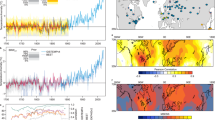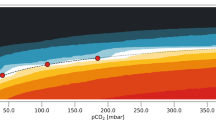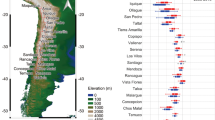Abstract
THE warming at the end of the last glaciation was characterized by a series of abrupt returns to glacial climate, the best-known of which is the Younger Dryas event1. Despite much study of the causes of this event and the mechanisms by which it ended, many questions remain unresolved1. Oxygen isotope data from Greenland ice cores2–4 suggest that the Younger Dryas ended abruptly, over a period of about 50 years; dust concentrations2,4 in these cores show an even more rapid transition (≲20 years). This extremely short timescale places severe constraints on the mechanisms underlying the transition. But dust concentrations can reflect subtle changes in atmospheric circulation, which need not be associated with a large change in climate. Here we present results from a new Greenland ice core (GISP2) showing that snow accumulation doubled rapidly from the Younger Dryas event to the subsequent Preboreal interval, possibly in one to three years. We also find that the accumulation-rate change from the Oldest Dryas to the Bø11ing/Allerød warm period was large and abrupt. The extreme rapidity of these changes in a variable that directly represents regional climate implies that the events at the end of the last glaciation may have been responses to some kind of threshold or trigger in the North Atlantic climate system.
This is a preview of subscription content, access via your institution
Access options
Subscribe to this journal
Receive 51 print issues and online access
$199.00 per year
only $3.90 per issue
Buy this article
- Purchase on Springer Link
- Instant access to full article PDF
Prices may be subject to local taxes which are calculated during checkout
Similar content being viewed by others
References
Bard, E. & Broecker, W. S. The Last Deglaciation: Absolute and Radiocarbon Chronologies, NATO ASI Series I, Vol. 2 (Springer, Berlin, 1992).
Dansgaard, W., White, J. W. C. & Johnsen, S. J. Nature 339, 532–534 (1989).
Johnsen, S. J. et al. Nature 359, 311–313 (1992).
Taylor, K. T. et al. Nature (in the press).
Langway, C. C. Jr U.S. Army Cold Regions Res. Engng Lab. Res. Rep. 77 (1967).
Alley, R. B., Saltzman, E. S., Cuffey, K. M. & Fitzpatrick, J. J. Geophys. Res. Lett. 17, 2393–2396 (1990).
Hammer, C. U. J. Glaciol. 25, 359–372 (1980).
Taylor, K. T. et al. J. Glaciol. 38, 325–332 (1993).
Hammer, C. U. in Isotopes and Impurities in Snow and Ice IAHS Publ 118, 297–301 (1977).
Palais, J. M., Taylor, K., Mayewski, P. A. & Grootes, P. Geophys. Res. Lett. 18, 1241–1244 (1991).
Fiacco, R. J. Jr., Palais, J. M., Germani, M. S., Zielinski, G. A. & Mayewski, P. A. Quat. Res. (in the press).
Mangerud, J., Andersen, S. T., Berglund, B. E. & Donner, J. J. Boreas 3, 109–128 (1974).
Berglund, B. E. Boreas 8, 89–117 (1979).
Fairbanks, R. G. Paleoceanography 5, 937–948 (1990).
Bard, E., Fairbanks, R. G., Hamelin, B. & Arnold, M. in The Last Deglaciation: Absolute and Radiocarbon Chronologies NATO ASI Series I, Vol. 2 (eds Bard, E. & Broecker, W. S.) 103–110 (Springer, Berlin, 1992).
Schøtt, C., Waddington, E. D. & Raymond, C. F. J. Glaciol. 38, 162–168 (1992).
Dahl-Jensen, D. & Gundestrup, N. S. in The Physical Basis of Ice Sheet Modelling (eds Waddington, E. D. & Walder, J. S.) IAHS Publ. 170, 31–43 (1987).
Alley, R. B. J. Glaciol. 38, 245–256 (1992).
Broecker, W. S. in The Last Deglaciation: Absolute and Radiocarbon Chronologies NATO ASI Series I, Vol. 2 (eds Bard, E. & Broecker, W. S.) 173–181 (Springer, Berlin).
Jouzel, J. et al. Quat. Res. 31, 135–150 (1989).
Dansgaard, W. Tellus 16, 436–468 (1964).
Hammer, C. U., Clausen, H. B. & Tauber, H. Radiocarbon 28, 284–291 (1986).
Rozanski, K. et al. in The Last Deglaciation: Absolute and Radiocarbon Chronologies NATO ASI Series I, Vol. 2 (eds Bard, E. & Broecker, W. S.) 69–80 (Springer, Berlin, 1992).
Becker, B. & Kromer, B. Radiocarbon 28(2B), 961–967 (1986).
Kromer, B. & Becker, B. in The Last Deglaciation: Absolute and Radiocarbon Chronologies NATO ASI Series I, Vol 2 (eds Bard, E. & Broecker, W. S.) 3–11 (Springer, Berlin, 1992).
Björck, S., Cato, I., Brunnberg, L. & Strömberg, B. in The Last Deglaciation: Absolute and Radiocarbon Chronologies NATO ASI Series I, Vol. 2 (eds Bard, E. & Broecker, W. S.) 25–44 (Springer, Berlin, 1992).
Zolitschka, B., Haverkamp, B. & Negendank, J. F. W. in The Last Deglaciation: Absolute and Radiocarbon Chronologies NATO ASI Series I, Vol. 2 (eds Bard, E, & Broecker, W. S.) 81–101 (Springer, Berlin, 1992).
Author information
Authors and Affiliations
Rights and permissions
About this article
Cite this article
Alley, R., Meese, D., Shuman, C. et al. Abrupt increase in Greenland snow accumulation at the end of the Younger Dryas event. Nature 362, 527–529 (1993). https://doi.org/10.1038/362527a0
Received:
Accepted:
Issue Date:
DOI: https://doi.org/10.1038/362527a0
This article is cited by
-
Into the Holocene, anatomy of the Younger Dryas cold reversal and preboreal oscillation
Scientific Reports (2024)
-
Pollen and grain size characteristics recorded from evaporite in the Kumishi Basin in arid Central Asia: implications for climate and environmental change since the late glacial
Carbonates and Evaporites (2024)
-
Hydroclimate response of spring ecosystems to a two-stage Younger Dryas event in western North America
Scientific Reports (2022)
-
Influence of the Late Quaternary climate on sedimentology of the Jazmurian Playa, SE Iran
Journal of Paleolimnology (2022)
-
Biotic response of benthic foraminifera to OMZ variations in the northwestern Pacific since the last deglaciation
Geo-Marine Letters (2021)
Comments
By submitting a comment you agree to abide by our Terms and Community Guidelines. If you find something abusive or that does not comply with our terms or guidelines please flag it as inappropriate.



